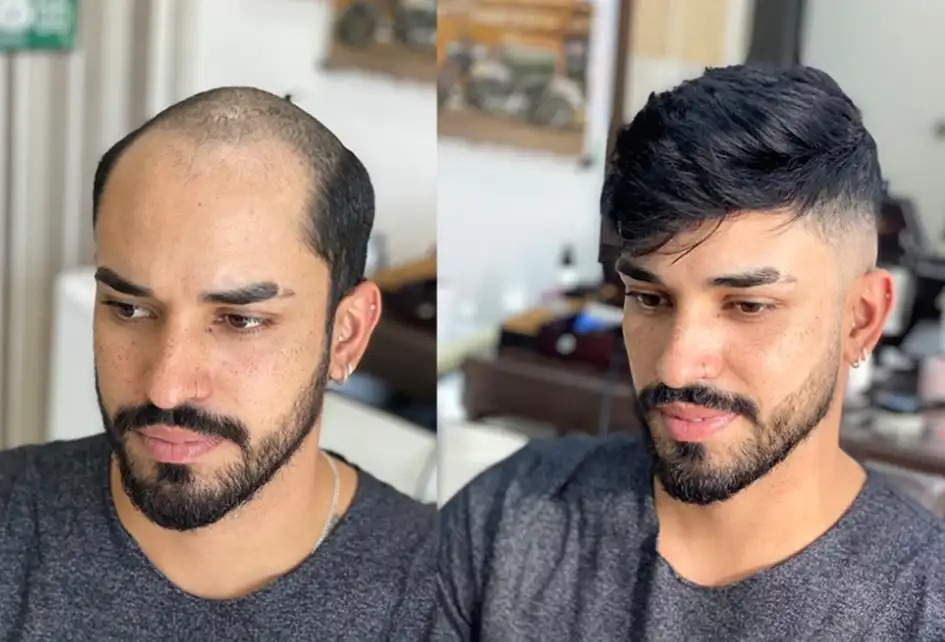Free Consultation, Call Now 416-902-2126
4 Reasons Why a Hair System is Better Than a Hair Transplant
Struggling with hair loss and unsure whether to choose a hair system or a hair transplant? This blog highlights four key reasons why a hair system might be the better option. From instant results and non-invasive application to affordability and styling versatility, we’ll explore why many people prefer this solution over surgery. Learn how a high-quality hair system can provide a natural look, require no recovery time, and offer a customizable appearance—all without the risks of a transplant.
3/11/20256 min read


Understanding Hair Systems and Hair Transplants
As individuals seek solutions for hair loss, two prominent options become evident: hair systems and hair transplants. Each method serves the purpose of restoring hair but operates through distinct processes and yields varied results. Understanding these differences is essential for those considering treatment for their hair thinning or baldness.
Hair systems, often referred to as hairpieces or wigs, are non-invasive solutions that involve the application of a synthetic or natural hair component attached to the scalp or remaining hair. These systems can be custom-designed to match the individual’s hair color, texture, and style preferences. The application typically involves bonding agents that secure the hair system in place, allowing for a seamless appearance. Maintenance of hair systems often requires periodic adjustments and care, but they do enable individuals to immediately achieve fuller hair without any surgical intervention.
On the other hand, hair transplants involve a surgical procedure where hair follicles are harvested from a donor site, usually from the back or sides of the scalp, and implanted into balding areas. This method utilizes two primary techniques: Follicular Unit Transplantation (FUT) and Follicular Unit Extraction (FUE). Both techniques aim to provide a more permanent solution to hair loss by promoting natural hair growth in the transplanted areas. However, recovery time and potential side effects, such as scarring or infections, may accompany this invasive procedure.
It is important to understand that while hair systems provide an instant solution without the need for surgery, hair transplants offer the potential of long-term growth and a natural look once healed. The fundamental differences lie in the procedures, recovery times, and results expected from each treatment, which significantly influence an individual’s choice when it comes to addressing hair loss.
1. Immediate Results and Convenience
One of the most significant advantages of a hair system over a hair transplant is the immediacy of results. When opting for a hair system, individuals can enjoy a full head of hair almost instantly. The fitting process is relatively quick, allowing individuals to leave the salon or clinic with a refreshed appearance in a matter of hours. This stands in stark contrast to hair transplants, which often require a considerable healing period before noticeable results can be seen. Following a hair transplant procedure, patients must endure a waiting phase for hair growth that can take several months. The anticipation can be quite daunting, especially for those who are seeking immediate improvement in their appearance.
Moreover, the convenience of using hair systems extends beyond just fast results. These systems are designed to be user-friendly and can easily be maintained in everyday life. Once fitted, hair systems can be styled, washed, and cared for much like natural hair. This allows individuals to seamlessly integrate their new look into their daily routines without substantial adjustments. They can engage in various activities, such as exercising or swimming, without the same level of concern often associated with post-transplant care, which necessitates more careful handling during the initial healing period.
The accessibility of hair systems also caters to a diverse range of lifestyles. Whether one is a busy professional or a parent managing multiple responsibilities, the ease of application and maintenance plays a pivotal role. Individuals can opt for different styles, colors, and textures according to their preferences, offering flexibility that is often limited with hair transplants. Overall, the immediate results and ease of convenience provided by hair systems make them a compelling choice for those looking to enhance their appearance without the delays characteristic of hair transplant procedures.
2. Non-Invasive and Reversible
Hair systems, also known as hairpieces or wigs, offer a compelling alternative to traditional hair transplant procedures due to their non-invasive nature. Unlike hair transplantation, which involves surgical techniques to remove hair follicles from one area of the scalp and implant them into another, hair systems simply require the application of a product that seamlessly mimics natural hair. This means that individuals who choose hair systems can avoid the risks associated with surgery, such as infections, anesthesia complications, and scarring.
Furthermore, hair systems can typically be fitted in a matter of hours without the need for lengthy recovery times. Patients who undergo hair transplant surgery often need to take significant time off for healing, which may not be feasible for everyone. In contrast, with a hair system, users can immediately enjoy the cosmetic benefits without the lengthy downtime, allowing them to maintain their regular lifestyle.
Another significant advantage of hair systems is their inherent flexibility. They can be easily styled, customized, and even changed according to personal preferences or fashion trends. Unlike a permanent hair transplant, which commits individuals to a specific look, hair systems allow users to experiment with different styles, colors, and lengths. This adaptability means that if one wishes to switch their appearance or simply try something new, they can do so effortlessly. Additionally, for those who may experience changing hair loss patterns, hair systems can be adjusted or replaced as needed, making them a more versatile solution compared to the permanent nature of surgical implants.
In conclusion, the non-invasive and reversible qualities of hair systems provide both flexibility and convenience that hair transplants cannot match. By avoiding surgery, individuals not only reduce health risks and recovery time but also gain the ability to change their look quickly and easily, making hair systems an attractive choice for many seeking to address hair loss.
3. Cost-Effectiveness and Budget-Friendly Options
When considering solutions for hair loss, the financial implications can play a crucial role in the decision-making process. Hair transplants typically entail a significant upfront investment that can range from several thousand to tens of thousands of dollars. This includes the surgical procedure itself, which is often accompanied by pre-operative consultations and post-operative care. Furthermore, the costs may not end there; many patients may also require additional procedures over time to maintain results, creating an ongoing financial commitment. This immediate and potential long-term expense can be a deterrent for many individuals contemplating a hair restoration option.
In contrast, hair systems present a more economical and budget-friendly alternative. The initial costs associated with acquiring a hair system are generally much lower than those of a hair transplant. Prices for hair systems can vary widely based on quality, brand, and customization, but many affordable options are available without compromising on standards. For individuals looking for effective solutions within a constrained budget, hair systems can serve as a practical choice. Additionally, maintenance costs for hair systems typically consist of periodic replacements and routine care, which can be planned and budgeted for in advance, contributing to a more manageable financial outlook.
Furthermore, the versatility of hair systems allows consumers to opt for various styles and types, catering to different preferences without a prohibitive price tag. This flexibility means individuals can experiment with their look and select the best fit for their lifestyle. With the wide range of options available in the market, including synthetic and human hair alternatives, one can easily find a quality solution suitable for different budgets. Therefore, when factoring in both upfront and continuous expenses, it becomes evident that hair systems often extend a more cost-effective solution when compared to traditional hair transplant methods.
4. Customization and Versatility
The appeal of hair systems lies significantly in their high degree of customization and versatility, which sets them apart from traditional hair transplant procedures. Hair systems offer individuals the opportunity to tailor their hair according to personal preferences such as color, texture, and style. Unlike a hair transplant, where the results are typically fixed and irreversible, hair systems can be modified and adjusted over time to meet changing tastes or lifestyle needs.
One of the most attractive features of hair systems is the variety of options available. Users can choose from a diverse range of hair types, lengths, and colors. This means that individuals can match their hair system to their natural hair or even opt for a completely different look. Whether one desires a sleek bob, long flowing locks, or a vibrant color, hair systems can accommodate these preferences with ease.
Moreover, the versatility of hair systems allows wearers to experiment with their appearance without the long-term commitment associated with surgical options. For instance, those who wish to change hairstyles regularly, such as switching from straight to curly hair, can effortlessly do so with a hair system. This flexibility is particularly valuable for individuals who enjoy staying current with fashion trends or may want to adapt their style for specific occasions.
Additionally, customization extends beyond aesthetics. Many hair systems are designed for comfort and practicality, ensuring that they can be worn throughout daily activities. This adaptability makes hair systems an appealing choice for those seeking both style and function. Considering the broad range of customizable features available, hair systems undeniably provide an unmatched level of personalization that hair transplants cannot offer.
